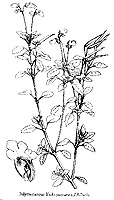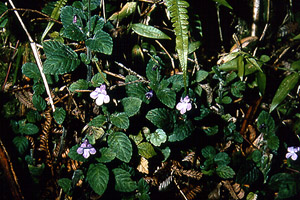

Left: C.B. Clarke in A. & C. DC., Monogr.
phan. 5/1, t. 12 (1883)
Right: phot. S. Vogel (1981)
Full name and orig. publication: Hovanella A.Weber & B.L.Burtt, Beitr. Biol. Pflanzen 70 (26 Nov. 1998, “1997”).
Etymology: A modification of the sectional name Didymocarpus sect. Hova. The Hova are one of the peoples of Madagascar.
Synonyms: Didymocarpus sect. Hova C.B.Clarke (1883).
Infrafamilial position: Didymocarpoid Gesneriaceae - "African and Madagascan genera” (Weber 2004).
Description: Perennial weak herbs. Stem erect, herbaceous, with few nodes, base decumbent, with fibrous roots. Leaves opposite, ± isophyllous, petiolate; lamina ovate, margin subentire or coarsely crenate. Cymes pedunculate, few-flowered. Sepals free to base. Corolla small, bluish to violet; tube short, broad, ventricose; limb slightly bilabiate, lobes small, rounded. Stamens 2 (the anterior ones), inserted near the corolla base, anthers coherent face to face. Nectary a low, lobed ring. Ovary cylindrical, channelled on the dorsal side in H. madagascarica, style short, stigma capitate. Fruit a capsule, held horizontally and making a ± right angle to the pedicel, dehiscence along the midrib of the upper carpel. Seeds verruculose.
Chromosome number: 2n = 28.
Species number: 2(3?) [H. madagascarica (C.B.Clarke) A.Weber & B.L.Burtt, H. vestita (Baker) A.Weber & B.L.Burtt, and possibly a third one].
Species names (incl. publication and synonyms): See Skog, L.E. & J.K. Boggan. 2005: World checklist of Gesneriaceae: http://persoon.si.edu/Gesneriaceae/Checklist.
Type species: Hovanella madagascarica (C.B.Clarke) A.Weber & B.L.Burtt
Distribution: E & C Madagascar.
Ecology: Terrestrial herb growing in damp, shady places in forest, on lateritic soils or on gneiss and granite rocks (Humbert et al. 1971).
Notes: The genus is one of the segregates of Didymocarpus s.l. (Weber & Burtt 1998d). Seed coat structure indicates clearly that Hovanella is closely allied to the African/Madagascan rather than to Asiatic genera. Molecular data suggest that the genus arose from within a group of Madagascan caulescent species of Streptocarpus subg. Streptocarpella (O’Sullivan 1999). The follicular plagiocarpic fruit apparently originated by convergence, by loss of fruit twist (rain splash dispersal in rain forest habitats), as happened several times in the evolution of Streptocarpus. The fruit of H. madagascarica is unique in that the halves of the upper carpel fold down to make a smooth channel.
Selected references: Burtt, In Humber & Leroy, Fl. Madagascar, 180. fam., Mus. Natl. L'Hist. Nat. (1971); O’Sullivan, MSc-Thesis, Univ. of Edinburgh (1999), molec. syst.
Bibliography: See Skog, L.E. & J.K. Boggan. 2005. Bibliography of the Gesneriaceae. 2nd edition: http://persoon.si.edu/Gesneriaceae/Bibliography.
Illustrations:
 |
 |
Hovanella madagascarica (C.B.Clarke)
A.Weber & B.L.Burtt
Left: C.B. Clarke in A. & C. DC., Monogr.
phan. 5/1, t. 12 (1883) |
last modified: 2007-07-13